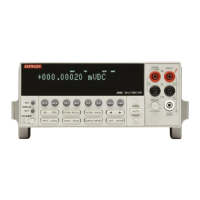D
IEEE-488 Bus Overview
D-1
Introduction
Basically, the IEEE-488 bus is simply a communication sys-
tem between two or more electronic devices. A device can be
either an instrument or a computer. When a computer is used
on the bus, it serves to supervise the communication
exchange between all the devices and is known as the con-
troller. Supervision by the controller consists of determining
which device will talk and which device will listen. As a
talker, a device will output information and as a listener, a
device will receive information. To simplify the task of keep-
ing track of the devices, a unique address number is assigned
to each one.
On the bus, only one device can talk at a time and is
addressed to talk by the controller. The device that is talking
is known as the active talker. The devices that need to listen
to the talker are addressed to listen by the controller. Each
listener is then referred to as an active listener. Devices that
do not need to listen are instructed to unlisten. The reason for
the unlisten instruction is to optimize the speed of bus infor-
mation transfer since the task of listening takes up bus time.
Through the use of control lines, a handshake sequence takes
place in the transfer process of information from a talker to a
listener. This handshake sequence helps ensure the
credibility of the information transfer. The basic handshake
sequence between an active controller (talker) and a listener
is as follows:
1. The listener indicates that it is ready to listen.
2. The talker places the byte of data on the bus and indi-
cates that the data is available to the listener.
3. The listener, aware that the data is available, accepts the
data and then indicates that the data has been accepted.
4. The talker, aware that the data has been accepted, stops
sending data and indicates that data is not being sent.
5. The listener, aware that there is no data on the bus, indi-
cates that it is ready for the next byte of data.
Bus description
The IEEE-488 bus, which is also frequently referred to as the
GPIB (General Purpose Interface Bus), was designed as a
parallel transfer medium to optimize data transfer without
using an excessive number of bus lines. In keeping with this
goal, the bus has only eight data lines that are used for both
data and with most commands. Five bus management lines
and three handshake lines round out the complement of bus
signal lines.
A typical set up for controlled operation is shown in Figure
D-1. Generally, a system will contain one controller and a
number of other instruments to which the commands are
given. Device operation is categorized into three operators:
controller, talker and listener. The controller does what its
name implies; it controls the instruments on the bus. The
talker sends data while a listener receives data. Depending on
the type of instrument, any particular device can be a talker
only, a listener only or both a talker and listener.
There are two categories of controllers: system controller,
and basic controller. Both are able to control other instru-
ments, but only the system controller has the absolute
authority in the system. In a system with more than one con-
troller, only one controller may be active at any given time.
Certain protocol is used to pass control from one controller
to another.

